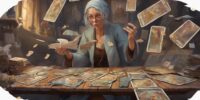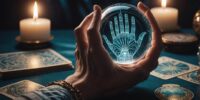How Juliet Sharman-Burke Bridged Tarot With Jungian Psychology
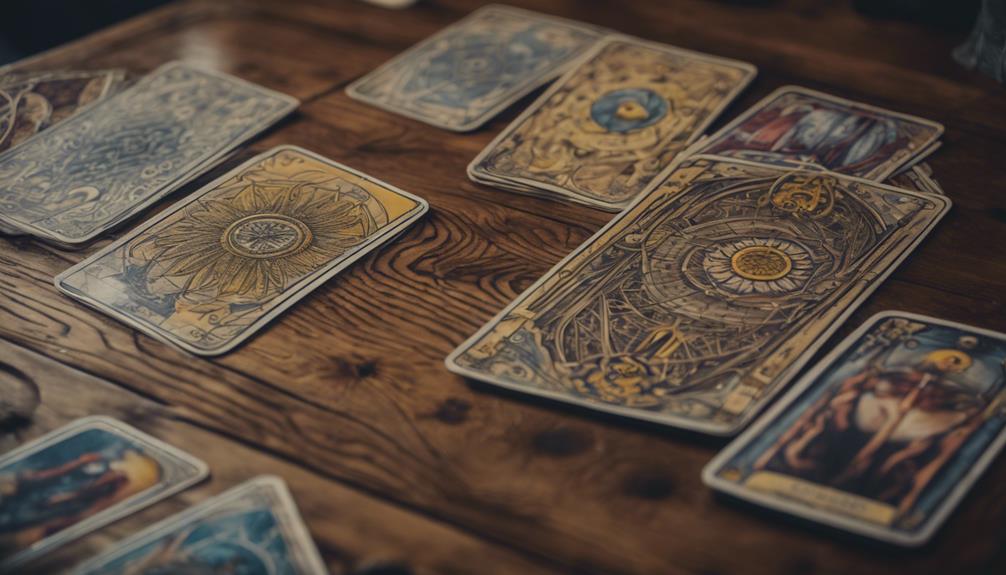
Juliet Sharman-Burke bridged Tarot with Jungian psychology to explore the depths of the unconscious and facilitate self-discovery through symbolism and archetypal concepts.
This unique approach offers a rich tapestry of meaning and insight, drawing on the collective unconscious to illuminate personal growth and transformation.
The Origins of Sharman-Burke's Approach
Exploring the roots of Sharman-Burke's approach reveals a deep integration of Jungian psychology with the intricate symbolism of Tarot cards. Juliet Sharman-Burke, a prominent figure in the field of Tarot and psychology, developed her methodology by drawing inspiration from the pioneering work of Carl Jung. The evolution of her approach can be traced back to her early exploration of the Tarot archetypes and their profound connection to the collective unconscious, a concept central to Jungian psychology.
Sharman-Burke's influence on the Tarot community stems from her unique perspective that views the Tarot not just as a tool for divination but as a mirror of the human psyche. By combining Jung's theories on archetypes and the individuation process with the symbolic language of the Tarot, she's created a method that offers deep insights and personal growth opportunities for individuals.
The significance of Sharman-Burke's approach lies in its ability to bridge the gap between psychology and spirituality, offering a holistic framework for self-exploration and introspection. Its impact can be seen in the way it has empowered individuals to explore into their subconscious territories, uncover hidden truths, and navigate life's complexities with greater clarity and wisdom.
Understanding Tarot Archetypes
Tarot archetypes serve as symbols that tap into universal human experiences, offering insights and reflections on the human psyche.
The connection between Tarot archetypes and Jungian psychology lies in their shared belief in a collective unconscious that shapes our behavior and perceptions.
Tarot Archetypes Explained
Within the intricate tapestry of the Tarot deck, each card holds a profound symbolic representation known as an archetype, embodying universal themes and human experiences. These tarot symbols are rich in meaning and lend themselves to psychological interpretation.
The archetypes present in the Tarot speak to the depths of the human psyche, reflecting a range of emotions, challenges, and growth opportunities. For instance, the Fool represents new beginnings and innocence, while the High Priestess embodies intuition and mystery.
Jungian Psychology Connection
The connection between Jungian psychology and Tarot archetypes reveals a profound interplay between universal symbols and the depths of the human psyche.
Tarot symbolism, deeply rooted in collective unconscious images, mirrors Jung's concept of archetypes. When exploring tarot cards through a psychological lens, individuals start on a journey of self-discovery and introspection. Each card represents a facet of human experience, inviting psychological exploration into the conscious and unconscious domains.
By delving into the rich tapestry of symbols within the tarot, one can uncover hidden aspects of the psyche and gain insights into personal growth and transformation.
The synergy between Jungian psychology and tarot symbolism offers a unique pathway for individuals to access the wisdom of the unconscious mind and navigate the complexities of the human experience.
Exploring Jungian Psychological Concepts
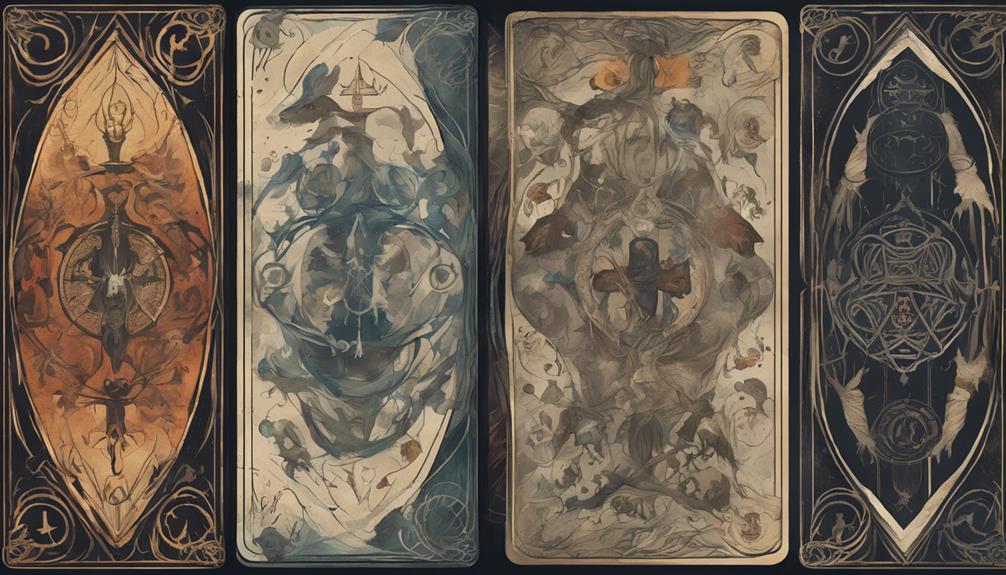
Within the domain of Jungian psychology lie profound concepts that parallel the symbolism found in Tarot. Archetypes in Tarot mirror the universal patterns present in the collective unconscious, offering insight into the human psyche.
Shadow work integration, a key aspect of Jungian psychology, can be seamlessly intertwined with Tarot readings to illuminate hidden aspects of the self.
Archetypes in Tarot
Exploring the Tarot through the lens of Jungian psychology reveals a rich tapestry of archetypes that resonate deeply with the human psyche. These archetypes, rooted in the collective unconscious, serve as mirrors for self-reflection, guiding individuals on their journeys of introspection and personal growth. Here are some key insights into the archetypes found in Tarot:
- The Fool: Represents innocence, new beginnings, and embracing the unknown.
- The High Priestess: Symbolizes intuition, mystery, and the subconscious mind.
- The Emperor: Embodies authority, structure, and taking control of one's life.
- The Lovers: Signify partnerships, choices, and the integration of opposites.
- The Tower: Reflects sudden change, upheaval, and the breaking down of illusions.
Through the exploration of these archetypes, Tarot offers a profound tool for inner exploration and spiritual development.
Shadow Work Integration
Bridging the depths of the subconscious mind with the transformative power of Tarot, shadow work integration explores the hidden aspects of the psyche and illuminates the path to self-discovery. By delving into the shadows of the unconscious, individuals engage in a process of self-exploration and personal growth. This journey involves confronting and integrating the suppressed or denied aspects of one's personality, often represented by the 'shadow' archetype in Jungian psychology. Through shadow work, individuals unearth buried emotions, fears, and desires, leading to a profound understanding of the self. Embracing the shadow self can be challenging but is essential for holistic personal development. Here is a table that illustrates the transformative process of shadow work:
| Acknowledge | Embrace | Integrate | Transform |
|---|---|---|---|
| Recognize and accept the shadow | Embrace the shadow with compassion | Integrate shadow aspects into consciousness | Transformative growth and self-realization |
Symbolism in Tarot and Jung
The symbolism found in Tarot cards and Jungian psychology intertwines to reveal profound insights into the human psyche. When exploring the connection between these two worlds, one can uncover a rich tapestry of meaning that speaks to the depths of the unconscious mind. Here are some key points to ponder:
- Archetypes: Both Tarot cards and Jungian psychology dive into the domain of archetypes, universal symbols that resonate across cultures and time periods.
- Imagery: The vivid imagery present in Tarot cards mirrors the symbolic language of the unconscious, offering a visual representation of Jungian symbols.
- Integration: By integrating tarot interpretations with Jungian concepts, individuals can gain a deeper understanding of their inner world and personal growth.
- Reflection: The process of reflecting on Tarot symbols through a Jungian lens can lead to profound insights and self-discovery.
- Transformation: Exploring the symbolism in Tarot and Jungian psychology can catalyze transformative experiences, guiding individuals on a journey of self-realization and empowerment.
The Collective Unconscious Connection
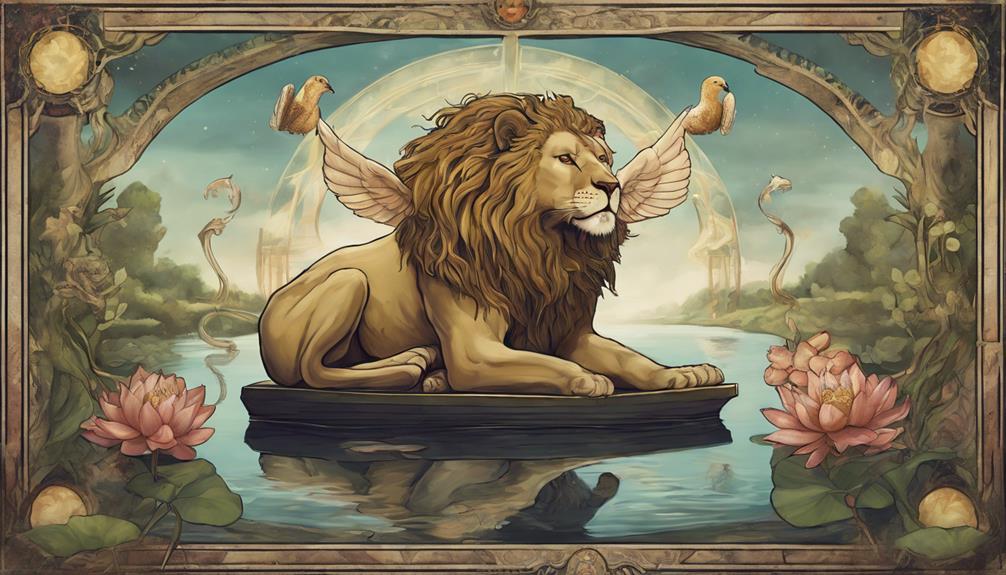
Delving into the depths of the human psyche, the connection between Tarot symbolism and Jungian psychology exposes profound insights into the collective unconscious. Tarot symbolism, with its rich tapestry of archetypes and imagery, provides a visual language that resonates deeply with the collective unconscious as described by Carl Jung. The concept of the collective unconscious suggests that there are universal, innate patterns of thought and behavior shared by all humanity, beyond the individual's personal experiences.
When exploring Tarot cards, individuals may find themselves drawn to certain symbols or archetypes that tap into this collective reservoir of shared meanings. For example, the Fool card can represent the beginning of a journey or a leap of faith, echoing universal themes of new beginnings and spontaneity that are ingrained in the collective unconscious. By delving into Tarot symbolism through a Jungian lens, individuals can access a deeper understanding of themselves and their place within the interconnected web of humanity's shared experiences and emotions.
Self-Reflection Through Tarot
Drawing on the rich tapestry of Tarot symbolism, individuals can set out on a journey of self-reflection and introspection by engaging with the archetypes and imagery within the cards. This process can lead to profound moments of self-discovery and personal growth. Through the practice of using Tarot for self-reflection, individuals can explore their innermost thoughts, feelings, and desires, gaining valuable insights into themselves and their lives.
Self-Reflection Through Tarot:
- Exploring the subconscious: Tarot cards can serve as mirrors to our subconscious mind, revealing hidden aspects of ourselves.
- Gaining clarity: By interpreting the symbols and messages in the cards, individuals can gain clarity on their current situations and challenges.
- Embracing transformation: Tarot encourages individuals to embrace change and transformation as part of their personal growth journey.
- Connecting with intuition: Engaging with Tarot can help individuals tap into their intuition and inner wisdom.
- Setting intentions: Using Tarot for self-reflection allows individuals to set intentions for their personal development and growth.
Integration of Tarot and Psychology
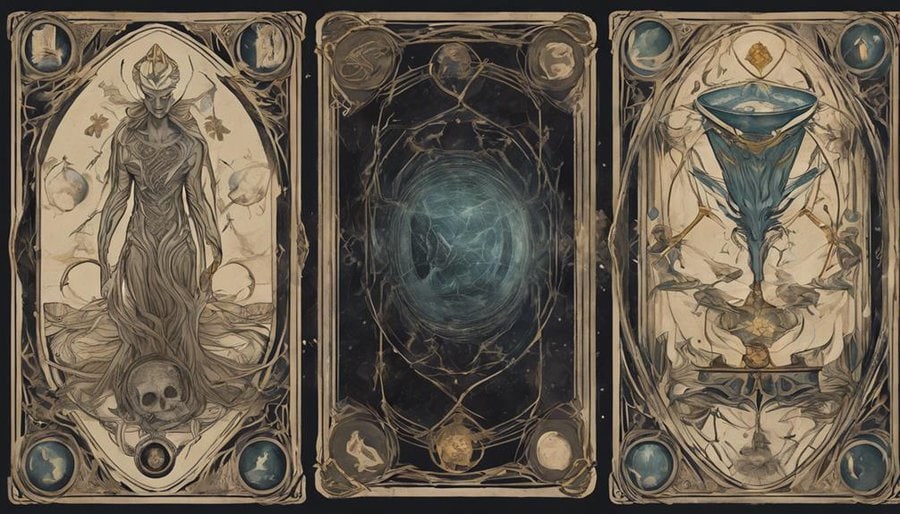
In the integration of Tarot and psychology, practitioners find a harmonious blend of ancient wisdom and modern therapeutic approaches. Tarot symbolism serves as a rich tapestry through which individuals can explore the depths of their psyche, revealing hidden truths and confronting unresolved issues. Psychology, on the other hand, provides a structured framework for understanding human behavior, motivations, and thought processes. When these two disciplines converge, a powerful tool for personal growth and integration emerges.
Through the lens of Tarot symbolism, individuals can access archetypal energies and universal themes that resonate with their own life experiences. By integrating psychological concepts such as self-awareness, shadow work, and individuation, Tarot practitioners can navigate their inner landscapes with greater clarity and insight. This fusion of ancient wisdom and modern psychology offers a holistic approach to self-discovery and transformation, inviting individuals to explore the depths of their subconscious minds in pursuit of healing and wholeness.
Benefits of Sharman-Burke's Method
Sharman-Burke's method of Tarot interpretation offers practitioners a unique approach that blends traditional symbolism with modern psychological insights, enhancing the exploration of the subconscious mind and facilitating personal growth. By combining these elements, Sharman-Burke's method provides a transformative experience for individuals seeking to probe deeper into their psyche and reveal hidden aspects of themselves.
The benefits of Sharman-Burke's approach include:
- Enhanced Self-Awareness: The method encourages individuals to ponder on their thoughts and emotions, leading to a deeper understanding of oneself.
- Clarity and Insight: Practitioners often gain new perspectives on their life circumstances, helping them make more informed decisions.
- Emotional Healing: Through the exploration of Tarot symbols and psychological concepts, individuals can begin a journey towards healing past wounds.
- Empowerment: Sharman-Burke's method empowers individuals to take charge of their lives and make positive changes.
- Spiritual Connection: The practice can foster a deeper connection to one's spirituality, leading to a sense of inner peace and fulfillment.
Frequently Asked Questions
How Does Juliet Sharman-Burke's Approach Differ From Traditional Tarot Reading Methods?
Juliet Sharman-Burke's approach to tarot differs from traditional methods through a comparative analysis that emphasizes modern interpretations. She explores into psychological symbolism and advocates for therapeutic application, enriching the practice with depth and introspection.
What Led Juliet Sharman-Burke to Combine Tarot With Jungian Psychology?
Juliet Sharman Burke's inspiration to merge tarot with Jungian psychology stemmed from a deep fascination with the human psyche. By intertwining these domains, she found a way to reveal profound insights and offer holistic guidance to seekers.
Can Anyone Learn to Use Sharman-Burke's Method, or Is It Only for Experienced Practitioners?
Learning Sharman-Burke's method is beginner accessible, but its depth unfolds with experience. While newcomers can grasp its basics, a profound understanding requires time and practice. The method's complexity rewards those willing to navigate its learning curve.
Are There Specific Tarot Decks That Work Best With Sharman-Burke's Approach?
When selecting a tarot deck for therapeutic benefits, personal preference plays an important role. The best deck is one that resonates with the individual, enhancing the integration of tarot into their personal journey and amplifying its therapeutic effects.
How Does Sharman-Burke's Method Address Issues of Mental Health and Personal Growth?
Sharman-Burke's method emphasizes mental wellness by exploring the symbolic language of tarot to investigate into personal development. Through archetypes and introspection, her approach offers a transformative journey that addresses mental health and fosters growth.



